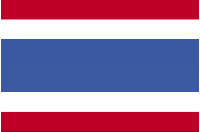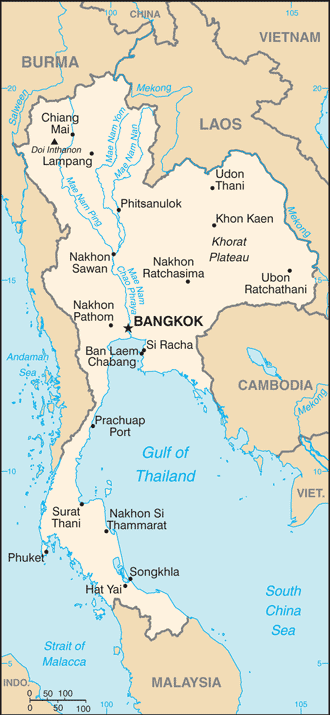Topics Covered
Welcome to Thailand
Overview of Resources
Metals
Industrial Minerals
Fossil Fuels
Investment
Sources
Welcome to Thailand
Thailand is located in southeastern Asia and borders the Gulf of Thailand and the Andaman Sea. The country has a total area of 513,120 km2 and a population of 67,091,089 as per 2012 reports. It has a tropical climate, cloudy southwest monsoon and cool northeast monsoon.
 |
The national flag of Thailand.
Image Credit: CIA Factbook. |
Thailand is awash with resources like fluorite, lignite, gypsum, lead, tantalum, tungsten, rubber, natural gas and tin. The country saw solid growth from 2000 to 2007 and the growth rate averaged over 4% per year thanks to its pro-investment policies, a free-enterprise economy, well-developed infrastructure, and strong export industries. However, the global financial crisis in 2008 to 2009 severely affected the country's exports. In 2010, exports rebounded and the country's GDP increased to $609.4 billion from $565.4 billion in 2009 and it reached $609.8 billion in 2011.
Overview of Resources
Thailand is one of the leading producers of tin, gypsum, feldspar and cement in the world. Other mineral resources of the country include coal, natural gas and petroleum. The country also has abundant reserves of zinc, iron, gold and copper.
In 2010, the country’s total value of exports amounted to $188.8 billion, which was an increase of 25% from the export value in 2009. This increase in value was mainly contributed by export of refined fuels and iron and steel products.

The map of Thailand. Image Credit: CIA Factbook
Metals
Chatree gold mine in central Thailand is owned by Kingsgate Consolidated Ltd. of Australia, which produced 4,125 kg of gold and 17,092 kg of silver from 2.7 Mt of ore in 2010. In 2011, the company planned to start the operation of a new additional unit built in Chatree north plant. The new unit has an annual ore processing capacity of more than 5 Mt, and its annual gold production accounts for about 6,200 kg. According to recent reports, in July 2012, the company produced 61,835 ounces of gold worth $US744 per ounce.
The Canadoil Group headquartered in Canada owns four manufacturing and fabrication facilities in Thailand. In 2010, the company invested $330 million for the construction of a metal and steel plate mill in Rayong. The mill is designed to have a maximum annual capacity of 1.2 Mt of steel in its first phase. In the same year, Tata Steel Thailand established a new mini blast furnace plant in Chonburi, which has an annual capacity of 500,000 t of steel.
Puthep Co. ltd. operates Puthep copper project located at Loei and has the PUT 1 and PUT 2 deposits. The PUT 1 deposit, which is Thailand’s largest known copper deposit, is estimated to have a production of 25,000 to 30,000 t of copper concentrates annually with total reserves of 160 Mt at grades of 0.53% copper and 0.09% gold.
Industrial Minerals
In 2010, Italcementi Group of Italy appointed Asia Cement Plc of Thailand to be the exclusive distributor for TX Active in the country. TX Active is the photocatalytic cement product that reduces compounds present in the air and impurities on building surfaces. The country’s cement production increased by 8.6% in 2010 to 36.5 million Mt from 33.6 Mt in 2009.
Thailand’s Somboon potash project owned by Asia Pacific Potash Ltd, a subsidiary of Italian-Thai development Public Co. Ltd, has a production capacity of 2 Mt/yr of potash. Nearly 1.6 Mt of the potash output from the plant will be exported and 0.4 Mt will be taken up for domestic consumption.
Fossil Fuels
In 2010, Thailand’s leading coal producer, Banpu PCL planned to purchase Australia’s Centennial Coal ltd., which owned 10 coal mines in New South Wales, Australia, and about 400 Mt of coal reserves.
In 2010, the annual production of the Bua Ban oilfield owned by the Coastal Energy Co. increased by 31%, compared to that of 2009, to an average of 9,670 barrels per day (bbl/d) of crude oil.
Investment
Thailand has plenty of identified mineral resources, which have been exploited for domestic consumption and export, thus attracting many foreign investments. Kingsgate plans to continue exploration and expansion activities at the Chatree Mine as a result of increasing gold price in the global market.
International iron and steel companies are likely to continue to invest in hot-rolling steel mills in the country thanks to a skilled workforce and good logistics facilities. Quebec Liberals has granted a $58-million loan to Mineral Fiber, which own the Jeffrey Mine, in an attempt to restore the dying asbestos industry. In addition, Baljit Chadha, co-owner of the mine has invested $11-million and Ulan Marketing has invested $14-million in the project. However, the government has recently banned asbestos production citing the harmful impact it has on human health.
In July 2011, the country’s income categorization was upgraded from a lower-middle income economy to an upper-middle income economy by the World Bank, which has also predicted the country’s economic growth to be more than 3.5% per year.
High inflation and political instability in the country could lead to shortages of steel products and delay or decrease in government investment. However, experts feel that with the increase in foreign investments and market demand for the country’s mineral commodities, the country’s mineral sector will likely see many positive changes in the near future.
Disclaimer: The Author of this article does not imply any investment recommendation and some content is speculative in nature. The Author is not affiliated in any way with any companies mentioned and all statistical information is publically available.
Sources
Disclaimer: The views expressed here are those of the author expressed in their private capacity and do not necessarily represent the views of AZoM.com Limited T/A AZoNetwork the owner and operator of this website. This disclaimer forms part of the Terms and conditions of use of this website.